|
|
File
Archeological Museum of the Magnificent Community of Cadore – Pieve di Cadore
|
Piazza Tiziano 2 – 32044 Pieve di Cadore (BL)
– Fax 0435 32858 |
  |
|
Summary
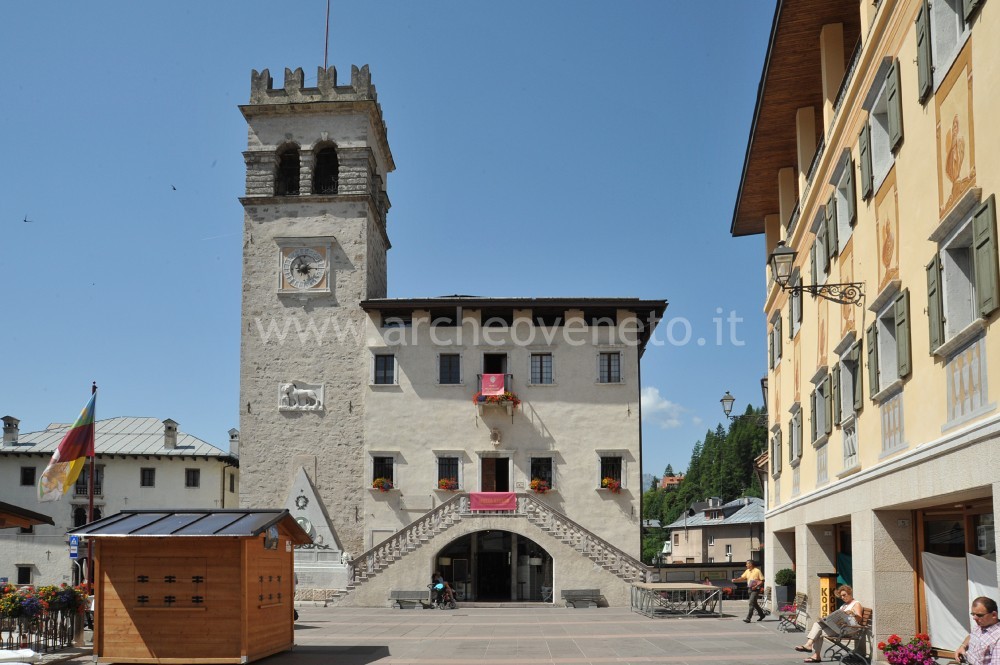
The Archaeological Museum is located on the second floor of the Ancient Palace of the Magnificent Community of Cadore. The collection includes pre-roman and roman artefacts, stemming solely from centres belonging to the historical Cadore region (Calalzo, Pieve, Valle, Domegge). The core part of the exhibition is made up of a remarkable amount of important findings discovered in the shrine of Làgole di Calalzo, which for long time has been a worship place for people from Veneto and Celts first, and then, until the late imperial age, for the Romanized people. The sacred area was used to worship the local deity, called Trumusiate or Tribusiate Sainate, which was later identified as Apollo.
Collection history
The establishment of the Archeological Museum of the Magnificent Community of Cadore dates back to 1880, when also the bronze monument to Titian placed at the centre of the homonymous square was unveiled. The collection has been then expanded over time thanks to the numerous items found in the shrine of Làgole di Calalzo and other parts of the Cadore area and today it is one of the richest and most homogeneous exhibitions in the province of Belluno, as well as the main point of reference as regards the ancient history of the whole Cadore region. The current layout of the museum dates back to 1984, which has recently been updated with the introduction of a winding path stretching along the entrance hall, where panels hanging on the walls provide brief and effective introductory explanations.
|

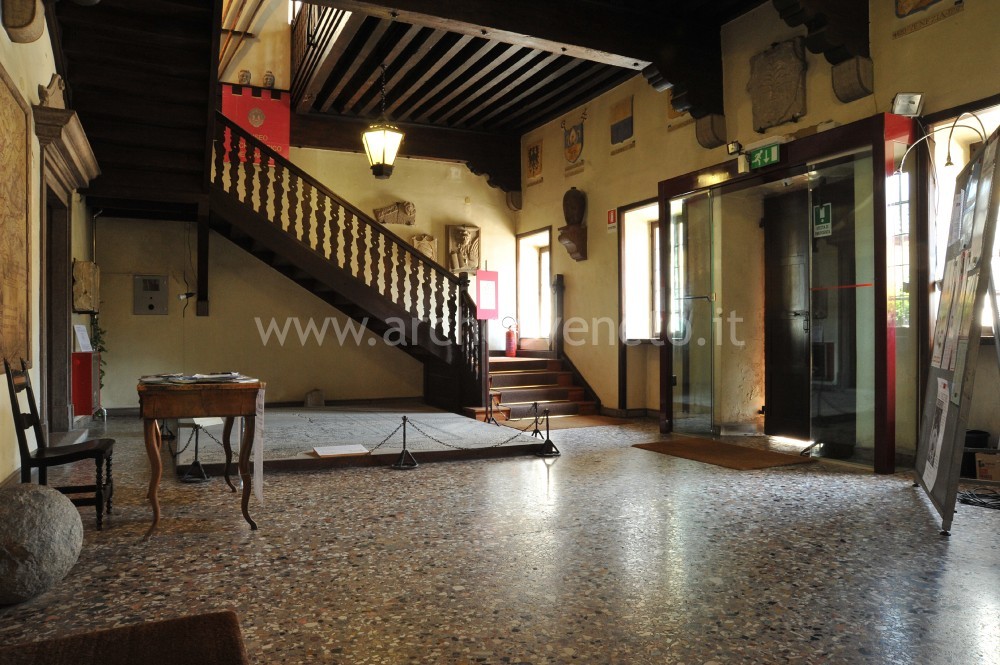 The court on the first floor of the Palace displays a broad fragment of a geometrical black and white mosaic (late 1st cent. – early 2nd century A.D.), which was originally placed in a heated area of the Roman house discovered in 1951-52 during the digging for the building of the Town Hall. On the right side, there is an inscription by L. Saufeius, of the Claudian tribe, found in the site of Fiès in Valle di Cadore, making reference to the donation of a schola (venue for meetings) and a solarium (terrace). The memorial tablet dates back to the 1st cent. A.D. The court on the first floor of the Palace displays a broad fragment of a geometrical black and white mosaic (late 1st cent. – early 2nd century A.D.), which was originally placed in a heated area of the Roman house discovered in 1951-52 during the digging for the building of the Town Hall. On the right side, there is an inscription by L. Saufeius, of the Claudian tribe, found in the site of Fiès in Valle di Cadore, making reference to the donation of a schola (venue for meetings) and a solarium (terrace). The memorial tablet dates back to the 1st cent. A.D.
|

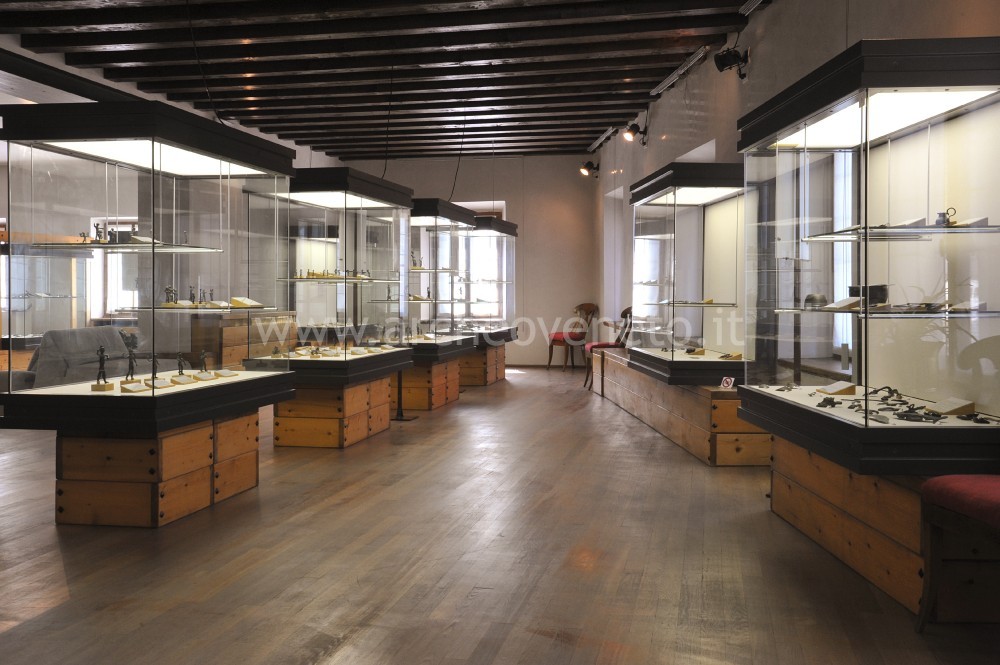 The room displays a broad and exhaustive range of archaeological remains found in the surroundings of the shrine of Làgole. In particular there are approximately 60 epigraphic attestations in the Venetic language (second-highest number after the National Museum of Este). The visit starts with the first display case on the right and follows a path that is not always linear, but that is clearly indicated by the numbers marked on each display rack. The room displays a broad and exhaustive range of archaeological remains found in the surroundings of the shrine of Làgole. In particular there are approximately 60 epigraphic attestations in the Venetic language (second-highest number after the National Museum of Este). The visit starts with the first display case on the right and follows a path that is not always linear, but that is clearly indicated by the numbers marked on each display rack.
The display case nr.1 contains numerous handles and bowls of simpula (small ladles) in bronze (4th- 3rd cent. B.C.), which are similar to those used to drink the healing water of the shrine spring. Many of these objects display the inscription to the ancient deity worshipped in Veneto, that is Trumusiate/Tribusiate Sainate. Usually handles and bowls were torn off on purpose to comply with the donation ritual. Two panels explain the function of these votive objects.
The visit goes on with the three display cases aligned on the right wall (2,3 and 4), which contain a set of votive bronze sheets, mainly characterized by the representation of horses at the centre and votive inscriptions on the edges.
Particularly noteworthy is the large and undamaged engraved sheet in the display case nr. 2, which shows a horse and an inscription to Trumusiate (5th cent. B.C.) and which has been chosen as symbol of the museum itself. These display cases are also accompanied by explanatory panels.
Then, the visit goes on with the display case nr. 5, which contains handles and bowls of simpula, similar to those contained in the first case, but which date back to the Roman age. Some of them display inscriptions to Trumusiate in Latin characters (at the top) and others to Apollo (in the central and lower part).
The display case nr. 6 shows bronze pots (whole pots or just fragments) dating back to the pre-Roman and Roman age. Particularly noteworthy is the fragment of a large basin, on which a (perhaps winged) horse is represented and which displays an inscription to Trumusiate. Next to the display case, there is a panel with explanations about the inscriptions of Làgole.
At the centre of the room, there are five aligned display cases (7-11), which contain tens of votive statuettes in bronze that have been found in the shrine.
The exhibition is accompanied by panels containing explanations on the votive objects of Làgole and the small bronzes. The display cases 7, 8 and 9 mainly contain objects representing warriors on the attack or resting warriors (4th – 3rd century B.C.), some of which clearly display Celtic traits. Yet there are also offering bearers. Well-known is the statuette of a warrior with a helmet in the case nr. 7, which displays an inscription to Trumusiate on one side. The display cases 10 and 11 contain numerous representations of Roman deities (Apollo, Jupiter, Mercury, Hercules, etc.), which clearly show the adoption of stylistic solutions belonging to the Hellenistic-Roman tradition; they date back to a time between the 2nd-1st cent. B.C. and to the late imperial age. A bended arm is the only example of anatomical ex-voto found in Làgole. The display case 12 also shows numerous coins mainly dating back to a period between the 1st cent. B.C. and the 4th cent. A.D., but there are also some coins of the Middle Ages.
The visit to the first room ends with the display case nr. 13, which contains men’s and women’s apparel accessories (mainly fibulae) donated to the shrine; there is a unique and very precious diadem, which still displays some gold leaves.
|

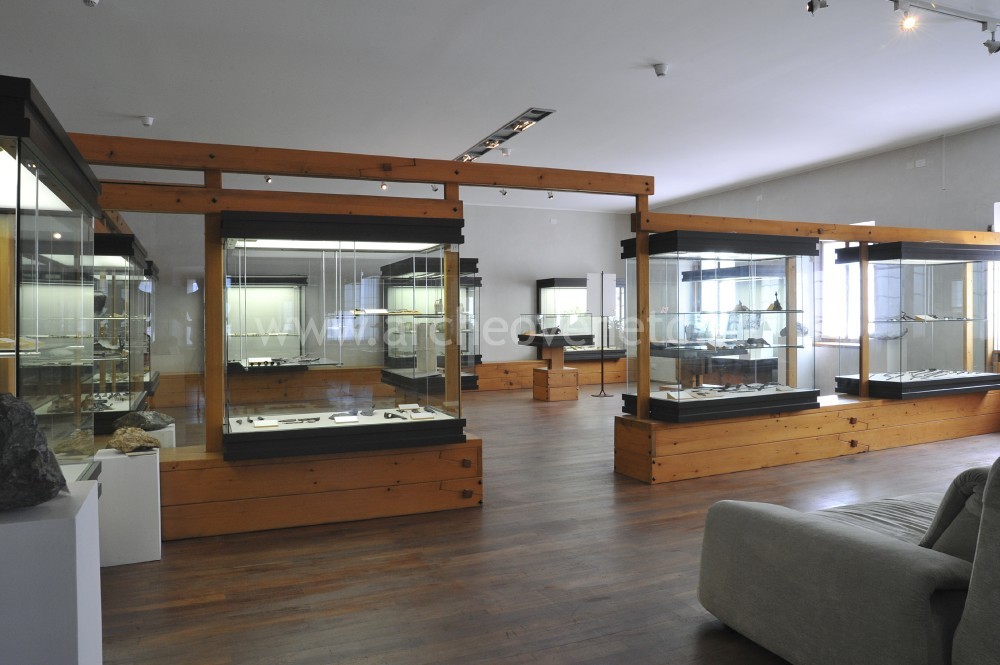 The room is divided into two areas by some display cases aligned at the centre of the space. The room is divided into two areas by some display cases aligned at the centre of the space.
The first area can be visited clockwise. The display case nr. 14 goes on with the exhibition of objects coming from the shrine of Làgole; it contains votive offers of different kind, such as rings, fragments of metal sheets, suspension hooks, decorative elements for the furniture, saddlery, ornamental elements like bronze pots and numerous tintinnabula (small bells). The three following display cases, aligned at the centre of the room, contain numerous items, most of which can be referred to objects and rites of Celtic origin. The display cases 15 and 16 contain numerous fragments of weapons left at the shrine of Làgole (helmets, shields, swords, spears and daggers); in particular the fragments of the helmets directly recall the famous and coeval Celtic helmet of Vallesella -in Domegge- (4th-3rd century B.C.) which is displayed in very good conditions in the case nr. 18, in the second section of the room. A panel on the right wall explains and describes the characteristics and the timeline of the Celtic weapons found in Làgole, mentioning also the historical importance of the small amount of findings dating back to the Imperial and late Ancient ages.
Also the display cases 17 and 19 contain very interesting objects: the first displays iron and bronze tools used to cook the meat of the sacrificed animals (bovid head shaped andirons, a series of spits), whereas the second one contains a set of bones and horns belonging to the animals themselves, as well as numerous iron tools and instruments (axes, anvils, hooks, knifes for the working of wood and/or for butchery). Next to them, the display case nr. 20 shows ceramic objects dating back to the Roman age. In the second section of the room, next to the helmet of Vallesella, the display case 21 is the last one containing finds coming from the shrine of Làgole: inside it there is a bronze situla (vessel) displaying a votive inscription to Trumusiate on the handle.
The three display cases aligned on the wall at the bottom of the room contain numerous objects dating back to the pre-Roman and Roman ages and coming from the settlement in Valle di Cadore: the exhibited artefacts include a series of small jugs and amphoras, which are undamaged and which in some cases display an inscription (case nr. 23), as well as iron carpentry tools (case nr. 24).
Also the two remaining display racks on the left side of the room contain objects found in Valle di Cadore. The display case nr. 25 shows metal items (situlae and simpula) dating back to the pre-roman and roman ages, coming from another shrine probably located in the site of Rusecco, which is very likely to have displayed some similarities with the shrine in Làgole, both in terms of objects found and of closeness to a river. The display case nr. 26 contains various objects which can be traced back to the Roman dwellings in Valle di Cadore (fragments of ceramic pots, cups and painted plaster), as well as tools dating back to the Longobard age that have been found in Domegge.
|
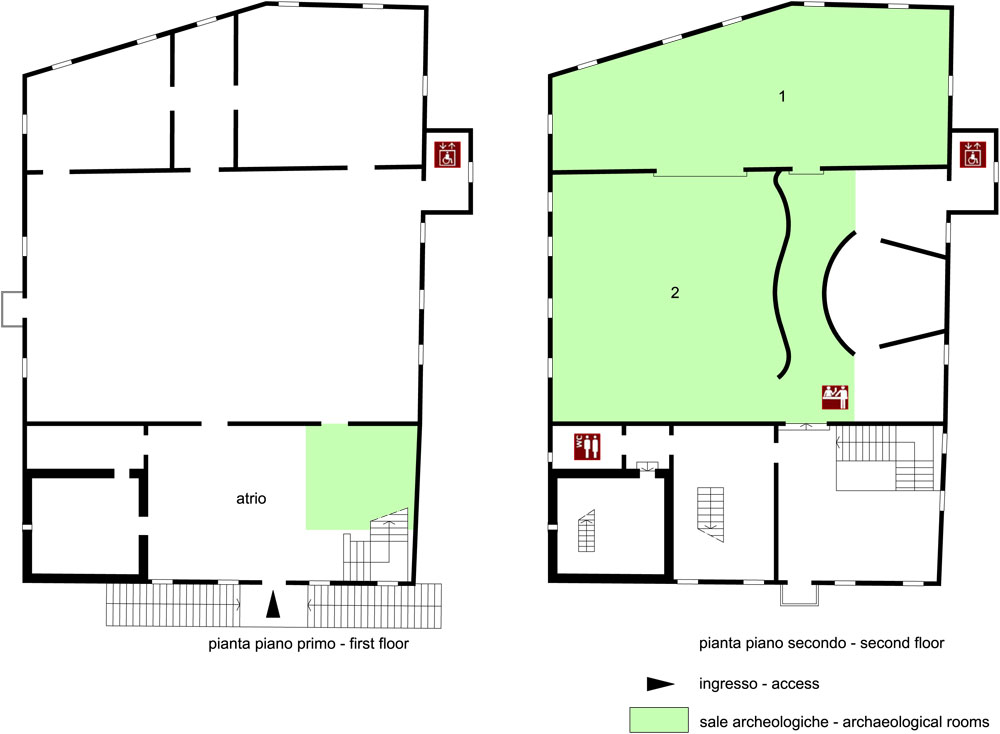
Admission: Negli orari di apertura
Ticket: Si
Price: Full fare: 3 € (adults)
Reduced fare: 2 € (children aged between 6 and 12, groups (min. 10 people), giornalists, students)
Free admission for children under 6 years of age; Combined ticket (Titian’s house; Archaeological museum, Eye glasses museum): 6 € (full price)
Combined ticket with Titian’s house: 5,00 € (full price); 3,50 € (reduced fare)
 School access School access
Free admission for students of the schools located in the Cadore area.
Opening Days
| Tipology |
When |
Specs |
| Spring/Summer |
Monday |
10.00-12.30 e 15.30-18.30 |
| Spring/Summer |
Tuesday |
10.00-12.30 e 15.30-18.30 |
| Spring/Summer |
Wednesday |
10.00-12.30 e 15.30-18.30 |
| Spring/Summer |
Thursday |
10.00-12.30 e 15.30-18.30 |
| Spring/Summer |
Friday |
10.00-12.30 e 15.30-18.30 |
| Spring/Summer |
Saturday |
10.00-12.30 e 15.30-18.30 |
| Spring/Summer |
Sunday |
10.00-12.30 e 15.30-18.30 |
The Museum can be visit also out of the opening times, taking an appointment 3/4 days before, calling on 0435.32262 or e-mailing on info@magnificacomunitadicadore.it.
Recommended tour time (minutes): 40
 Toilet Toilet
 Bookshop Bookshop
 Rest points Rest points
Numerous chairs and sofas.
 Bar/Resaturant Bar/Resaturant
On the ground floor of the Palace of the Magnificent Community.
 Catalogo Catalogo
Italian
 Information boards Information boards
Italian
 Mobile cards Mobile cards
Short but accurate two-page guide/information sheets, available in Italian and in English (2009)
 Captions under exhibits Captions under exhibits
Italian
 Multilingual ads: Inglese Multilingual ads: Inglese
Introductory panels at the entrance of the museum, information sheets.
 Other activities Other activities
Conference hall and exhibition spaces inside the Palace of the Magnificent community.
| Fogolari G. 1956, Il Museo Archeologico del Cadore, in Il Palazzo della Magnifica Comunità Cadorina e le sue raccolte., Padova, pp. 5-24. |
| Pellegrini G.B. 1991, Il Museo Archeologico Cadorino e il Cadore preromano e romano, Pieve di Cadore, pp. 261. |
| Materiali veneti preromani e romani del santuario di Lagole di Calalzo al Museo di Pieve di Cadore 2001, a cura di Fogolari G., Gambacurta G. , Roma. |
| Musei e raccolte archeologiche del Veneto 2004, a cura di Di Mauro A., Dosson di Casier, pp. 36-38. |
| Belli M.F. 2008, La Magnifica Comunità di Cadore e i suoi palazzi storici, pp. 111. |
| Bonetto J. 2009, Veneto (Archeologia delle Regioni d’Italia), Roma, pp. 426-428. |
|

